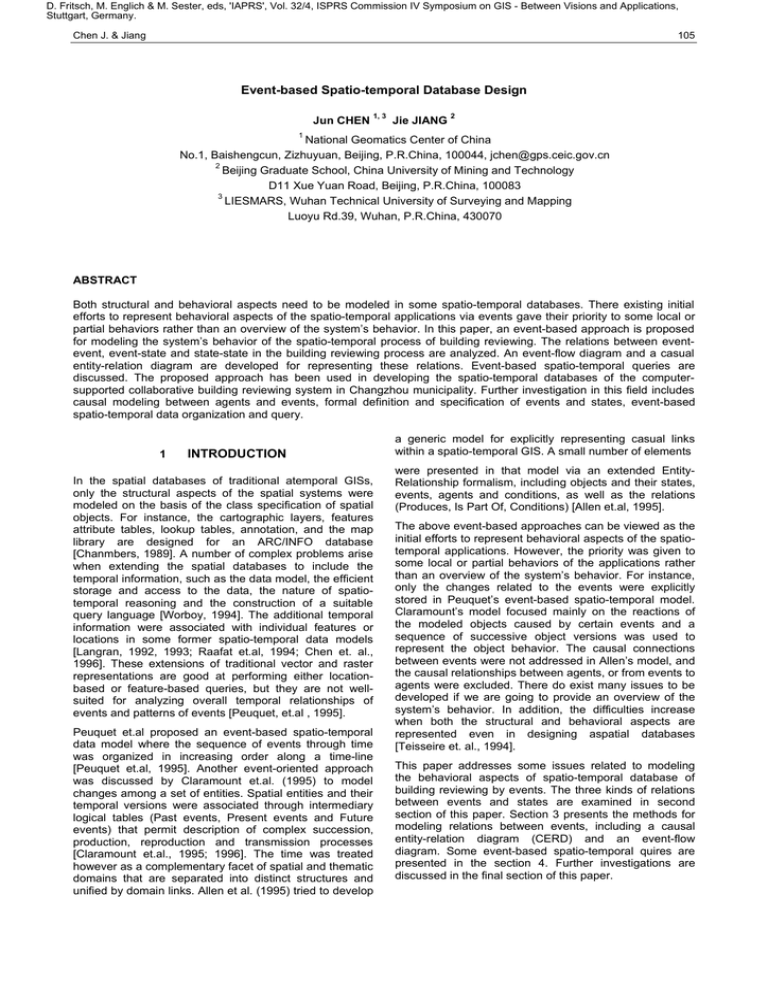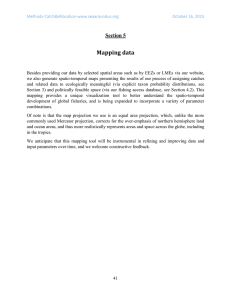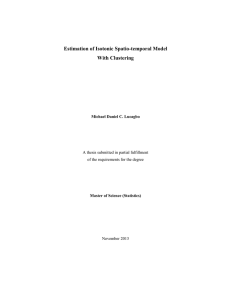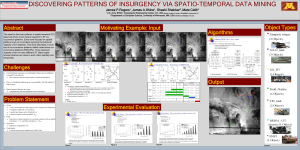Event-based Spatio-temporal Database Design
advertisement

D. Fritsch, M. Englich & M. Sester, eds, 'IAPRS', Vol. 32/4, ISPRS Commission IV Symposium on GIS - Between Visions and Applications, Stuttgart, Germany. Chen J. & Jiang 105 Event-based Spatio-temporal Database Design Jun CHEN 1, 3 Jie JIANG 2 1 National Geomatics Center of China No.1, Baishengcun, Zizhuyuan, Beijing, P.R.China, 100044, jchen@gps.ceic.gov.cn 2 Beijing Graduate School, China University of Mining and Technology D11 Xue Yuan Road, Beijing, P.R.China, 100083 3 LIESMARS, Wuhan Technical University of Surveying and Mapping Luoyu Rd.39, Wuhan, P.R.China, 430070 ABSTRACT Both structural and behavioral aspects need to be modeled in some spatio-temporal databases. There existing initial efforts to represent behavioral aspects of the spatio-temporal applications via events gave their priority to some local or partial behaviors rather than an overview of the system’s behavior. In this paper, an event-based approach is proposed for modeling the system’s behavior of the spatio-temporal process of building reviewing. The relations between eventevent, event-state and state-state in the building reviewing process are analyzed. An event-flow diagram and a casual entity-relation diagram are developed for representing these relations. Event-based spatio-temporal queries are discussed. The proposed approach has been used in developing the spatio-temporal databases of the computersupported collaborative building reviewing system in Changzhou municipality. Further investigation in this field includes causal modeling between agents and events, formal definition and specification of events and states, event-based spatio-temporal data organization and query. 1 INTRODUCTION In the spatial databases of traditional atemporal GISs, only the structural aspects of the spatial systems were modeled on the basis of the class specification of spatial objects. For instance, the cartographic layers, features attribute tables, lookup tables, annotation, and the map library are designed for an ARC/INFO database [Chanmbers, 1989]. A number of complex problems arise when extending the spatial databases to include the temporal information, such as the data model, the efficient storage and access to the data, the nature of spatiotemporal reasoning and the construction of a suitable query language [Worboy, 1994]. The additional temporal information were associated with individual features or locations in some former spatio-temporal data models [Langran, 1992, 1993; Raafat et.al, 1994; Chen et. al., 1996]. These extensions of traditional vector and raster representations are good at performing either locationbased or feature-based queries, but they are not wellsuited for analyzing overall temporal relationships of events and patterns of events [Peuquet, et.al , 1995]. Peuquet et.al proposed an event-based spatio-temporal data model where the sequence of events through time was organized in increasing order along a time-line [Peuquet et.al, 1995]. Another event-oriented approach was discussed by Claramount et.al. (1995) to model changes among a set of entities. Spatial entities and their temporal versions were associated through intermediary logical tables (Past events, Present events and Future events) that permit description of complex succession, production, reproduction and transmission processes [Claramount et.al., 1995; 1996]. The time was treated however as a complementary facet of spatial and thematic domains that are separated into distinct structures and unified by domain links. Allen et al. (1995) tried to develop a generic model for explicitly representing casual links within a spatio-temporal GIS. A small number of elements were presented in that model via an extended EntityRelationship formalism, including objects and their states, events, agents and conditions, as well as the relations (Produces, Is Part Of, Conditions) [Allen et.al, 1995]. The above event-based approaches can be viewed as the initial efforts to represent behavioral aspects of the spatiotemporal applications. However, the priority was given to some local or partial behaviors of the applications rather than an overview of the system’s behavior. For instance, only the changes related to the events were explicitly stored in Peuquet’s event-based spatio-temporal model. Claramount’s model focused mainly on the reactions of the modeled objects caused by certain events and a sequence of successive object versions was used to represent the object behavior. The causal connections between events were not addressed in Allen’s model, and the causal relationships between agents, or from events to agents were excluded. There do exist many issues to be developed if we are going to provide an overview of the system’s behavior. In addition, the difficulties increase when both the structural and behavioral aspects are represented even in designing aspatial databases [Teisseire et. al., 1994]. This paper addresses some issues related to modeling the behavioral aspects of spatio-temporal database of building reviewing by events. The three kinds of relations between events and states are examined in second section of this paper. Section 3 presents the methods for modeling relations between events, including a causal entity-relation diagram (CERD) and an event-flow diagram. Some event-based spatio-temporal quires are presented in the section 4. Further investigations are discussed in the final section of this paper. D. Fritsch, M. Englich & M. Sester, eds, 'IAPRS', Vol. 32/4, ISPRS Commission IV Symposium on GIS - Between Visions and Applications, Stuttgart, Germany. 106 2 IAPRS, Vol. 32, Part 4 "GIS-Between Visions and Applications", Stuttgart, 1998 RELATIONS BETWEEN EVENTS AND STATES IN BUILDING REVIEWING Building reviewing is a collaborative work by a group of urban planning staffs and land managers to review land use applications submitted by public agencies or private citizens, regarding new buildings or concerning existing building with or without change in their original functions. An application would be reviewed in a legally approved and sequential steps, requiring a quite long processing period from the submission to issuing the legal permits [Chen, et al, 1998a]. This spatio-temporal process can be viewed as a sequence of events which cause changes in both the geometric and thematic states, such as creating a new land parcel at a vacant space, decomposing an existing land parcel into smaller parcels [Chen, et. al. 1996]. From the point of view of behavioral modeling, there exist three different but related connections between events and states of the spatio-temporal application, i.e., links between events, links between an event and a state, and links between states, as shown in Fig.1. A. Deterministic relations between events The decision-making actions of planning staffs and land managers shown in Fig.1 can be viewed as events happened in building reviewing process, such as site locating, land subdivision, building permission, title registering, etc. Every of these events would be caused by a planning staff or land manager with the occurrence of a previous event as a condition. For instance, land subdivision will be carried out only after locating the construction site. Modeling these deterministic relations and conditions between events is one of the key issues in representing the system’s behavior. However, it should be kept in mind that the events in Fig.1 are upper level events and may always be decomposed into a sequence of sub-events. All hierarchical levels of events and their causal relations need to be maintained within the spatiotemporal databases. B. Relations between events and states The geometric and thematic states of building reviewing system are reflected by its integrated spatial and aspatial data. Occurrences of the events in Fig.1 may cause geometric changes and different events might bring about different geometric states. For instance, site selecting will create a new spatial object representing the planned location for the application. A landuse boundary will be laid out by the event land subdivision. Changes of states Site Locating Planned location Land Subdivision Clarified landuse boundary Links between events may also involve changes in attribute values or other alphanumeric data. It is essential to explicitly preserve known relations between events and their consequences. C. Causal relations between states As shown in Fig.1, there exist a causal link between present state and previous states. When determining the location of buildings, the clarified landuse boundary created in the previous step will be served as its basis. It is therefore important to maintain the historical states and current states, as well as their causal links. In other words, both the sates and their links need to be specified in designing spatio-temporal databases for building reviewing. Based on the above discussions, the links between events and states were modeled in developing a computer supported collaborative building reviewing system for the bureau of urban planning and land administration in Changzhou municipality. The disparate sources of data within that organization are integrated in the system. Network-based queries and collaborative spatial data handling and office automation functions were developed [Chen, et.al., 1998b]. The desktop spatial data handling functions consist of delineating land lot on digital maps, measuring and labeling coordinates and areas, plotting graphic maps, etc. The paper-work related office automation include registering an application, checking relevant documents, filling and transferring working tables, preparing legal permits and its associate graphic documents with official signatures, documenting and archiving. 3 MODELING LINKS BETWEEN EVENTS AND STATES The main events represented in the system are shown in Fig.3. One event would be caused by an agent or triggered by the occurrence of a previous event with some constraints. It may be instantaneous or have a duration, which is noted as an explicit attribute of the temporal link. Moreover, these events may consist of sets of lower level events. For instance, the event site locating will start with application registering where the application is accepted and registered. The application will be checked then by verifying whether it fits with the urban plans, planning laws, and other regulations. An appropriate location will be selected and statements on the construction will be given by the planner(s). The following sub-event is to prepare and issue a legal permit with a planned location map. Building Permission Permitted building area Links between states Title Registering Registered property Links between an event and a state Fig. 1 Sequential events and related states in building reviewing process D. Fritsch, M. Englich & M. Sester, eds, 'IAPRS', Vol. 32/4, ISPRS Commission IV Symposium on GIS - Between Visions and Applications, Stuttgart, Germany. Chen J. & Jiang 107 Event 1 Event 2 State 1 State 2 … Event n … State n Fig.2 Three kinds of links between events and states Submitting Applications Start Site Locating Land Subdivision Building Permission Permits Issuing Title Registering End Fig. 3 First-level events in building reviewing process The relations between these events (i.e., aggregation links, triggering chaining between events) should also be identified and represented with a hierarchical structure. An event schema will be further developed for describing the application behavior in terms of events. For a submitted building application, a sequence of legally defined events will be executed by planning staffs and land managers according to the nature of the applied case. While linking these events along a time-line, the new states brought out by them need also be explicitly represented. The successive spatial states in the building reviewing system are defined as composite spatial objects, such as planned location, clarified landuse boundary, permitted building area, registered property. A new state would be created or modified on the basis of the previous one. For instance, the clarified landuse boundary is delineated within the area of the planned location. In fact, the spatial and aspatial data produced at each processing stage of building reviewing will be transferred to the next working stage. In order to represent explicitly the casual linkages between these states, an causal entity-relation diagram (CERD) was designed by the authors in Fig.5. It should be noted that each state discussed here might be composed of sets of primitive spatial objects. These primitive spatial objects are defined and represented in the federated structural schema of the database [Chen, et.al, 1998a]. The ‘event-list’ in the middle of Fig.6. is an ordered event flow, where sequent events are connected with relevant states. This event flow provides both the system designers and users with an overview of the behavior of building review process. It makes it easier to query spatio-temporal changes, such as what event(s) happened at a given time period and what changes have been caused by the event(s). Event Site Locating Start End Application Registering Reasonableness checking Site selecting & Statement giving Fig 5 A causal entity-relation states printing in building & reviewing Documents filing diagram ofPermits Map delineating Fig. 4 Lower-level events in building reviewing process D. Fritsch, M. Englich & M. Sester, eds, 'IAPRS', Vol. 32/4, ISPRS Commission IV Symposium on GIS - Between Visions and Applications, Stuttgart, Germany. 108 IAPRS, Vol. 32, Part 4 "GIS-Between Visions and Applications", Stuttgart, 1998 General Plan Permitted Building Area 1:n 1:n 1:n Local Plan n:1 Planned Location 1:n n:1 1:1 Registered Property Detail Plan 1:n 1:n 1:1 1:1 Building Design 1:1 Clarified Landuse Fig. 5 A causal entity-relation diagram of states in building reviewing 4 EVENT-BASED SPATIO-TEMPORAL QUERIES Among the various queries of the building reviewing system, some kinds of event-based queries are developed for accessing event-related spatio-temporal data. A. Event-based process query For a given building application, it is easy to access the current, previous and following reviewing steps with the event-list. In other words, it is possible to know how many steps the building application has gone through, what are the current and the other remained reviewing stages. -Application Forms - Assessment Form - Related Laws - General Plan - Local Plans - Detail Plans Application Registering Reasonableness Checking It is also possible for a given reviewing stage to know how many application cases have been reviewed in a given period of time and what are the applications under reviewing. This kind of process query is very often used by the administrator(s), planning staffs and land managers. Moreover, process query may be answered at different levels with the hierarchical structure of events. B. Event-based change query The relevant states and other documents can also be retrieved with the help of the linkages between events and the states. For instance, tracking issued permits is a regular work in the urban development control which is based on the distribution of all the parcels approved or building occupancy permitted. It can be viewed as the overall changes caused by the relevant events since a specific time and can be retrieved from the modeled relations between events and stages. - Planned Landuse Location - Statement of Construction Site Selecting & Statement Giving Event list Document Filing - Legal Permits - Location Maps - Assessment Form Permits Printing & Map Delineating - Legal Permits - Location Maps Fig. 6 Event flow with associated states D. Fritsch, M. Englich & M. Sester, eds, 'IAPRS', Vol. 32/4, ISPRS Commission IV Symposium on GIS - Between Visions and Applications, Stuttgart, Germany. Chen J. & Jiang 5 109 FURTHER INVESTIGATIONS It can be seen from the above discussion that the representation of the links between event-event, eventstate and state-states is very essential to model the behavioral aspects of building review process. The event-based spatio-temporal database approach proposed in this paper has been used in developing a computer-supported collaborative building reviewing system in Changzhou municipality. However, there remains many other problems and issues to be solved for modeling both the structural and behavioral aspects of the spatio-temporal system. Further investigation includes: A. Causal modeling between agents and events: There exist causal relations between agents and events that reflect the human-human interactions in the collaborative reviewing process. A better understanding of this kind of relation will be important for representing the dynamic behavior of the system. This will help the designers to classify and define the system functions properly, which will enable the end users to concentrate on problem solving and decision making tasks at the semantic level. B. Formal definition and specification of events and states: The events and states as well as their relations need to be defined and specified with formal approaches. This would be helpful for formalizing the event schema and Links between the structural and behavioral specifications. C. Event-based spatio-temporal data organization and query: Conceptual and technical issues need to be examined or analyzed for developing the spataotemporal data organization and index mechanism, such as versioning spatio-temporal objects, maintaining spatio-temportal topology, event-based indexing. ACKNOWLEDGEMENT This research was supported by Natural Science Foundation of China (NSFC) under grant number 49671061. REFERENCES Allen, A., Edwards, G. and Bedard, Y., 1995, Qualitative causal modeling in temporal GIS, Spatial Information Theory- A theoretic basis for GIS, Springer-Verlag, No. 988, pp.397-412 Chanmbers, Don, 1989, Overview of GIS database design, ARC News, Spring 1989 issue, Vol.11, No.2 Claramunt, C. and M. Theriault, 1995, Managing time in GIS: an event-oriented approach, Recent Advances in Temporal Databases , Springer, pp.23-43 Claramunt, C. and M. Theriault, 1996,Toward semantics for modelling spatio-temporal processes within GIS, SDH’96, pp.2.27-2.43 CHEN, Jun, Yanfen LE, 1996, Defining and representing temporal objects for describing the spatio-temporal process of land Subdivision, in Intenational Archieves of ISPRS , Part B2, pp. 4956, Vienna, 1996 CHEN, Jun, Jie JIANG, Ronghua YAN, Shuping JIN, Lilin XU, 1998a, Towards collaborative building reviewing by integrating GIS with office automation, Proceedings of International Conference on Modeling Geographical and Environmental Systems with GISs, Hong Kong, June, 1998 CHEN, Jun, Jie JIANG, Ronghua YAN, Xiaoping WANG and Lilin XU, 1998b,Integrating and managing heterogeneous geographic information for urban planning & land administration, Acta Geodaetica et Cartographica Sinica, Vol.27, No.2 Langran, G. 1992. Time in GISs, Talor&Francis, 1992. Langran, G., 1993, Issues of implementing a spatiotemporal system, Int. J. Geographic Information Systems,Vol.7, No.4, 305-314 Raafat, H., Zhongshen Yang and D. Gauthier. 1994. Relational spatial topologies for historical geographical information, Int. J. Geographic Information Systems, Vol.8, No.2, pp.163-173. Peuquet, D. J. and N. Duan, 1995, an event-based spatiotemporal data moadl (ESTDM) for temporal analysis of geographical data, Int. J. Geographic Information Systems, Vol.9, No.1, pp.7-24 Teisseire, M., P. Poncelet, R. Cicchetti, 1994, Towards Event-Driven Modelling for Database Design, Proceedings of the 20th VLDB Conference, Santiage, Chile, pp.285-296 Worboy, M.F., 1994, A uniform model for spatial and temporal information, The Computer Journal, 37(1):26-34




